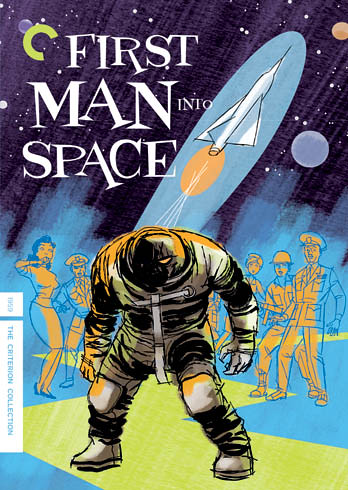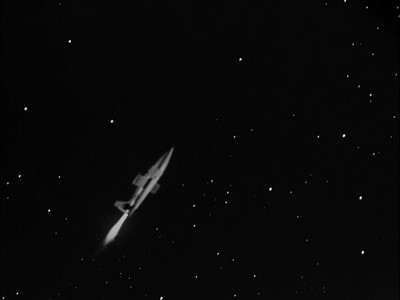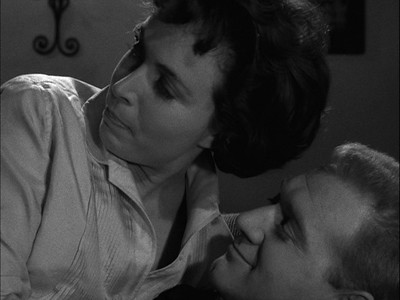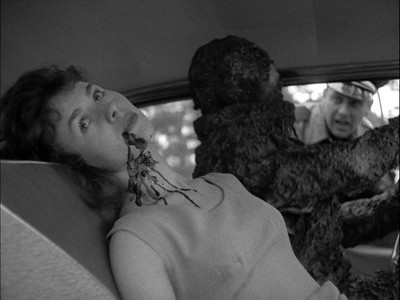
Inspired by the good time of reviewing Robinson Crusoe on Mars last week, as well as enjoying the irony of exploring the vastness of outer space while being snowed in for an especially chilly Oregon winter, I decided this week to watch another old sci-fi film, First Man Into Space. It's part of the Monsters & Madmen collection, the Darwyn Cooke cover art for which is currently featured as a limited edition print in the Criterion store.

Though during my October horror fest I had reviewed the spookier titles from Monsters & Madmen, I hadn't yet sampled the more space-age selections. Directed by Robert Day, from a story by Wyott Ordung and a screenplay by John C. Cooper and Lance Z. Hargreaves (what names these guys have!), First Man Into Space is of the same hopeful yet cautious ilk as other 1950s astronaut movies. Released in 1959, two years after Laika had gone into orbit, the movie raises the next logical question: how do we get a human being up there?
Well, it kind of asks the question. Though many of the sci-fi chillers of the 1950s carried a secret message, either about the effects of Communism or even the dangers of meddling with forces beyond our scope in the Atomic Age, one really has to force a square peg into a round hole to divine a greater meaning out of First Man Into Space. Sure, there are cursory reminders to remember the human element in our efforts to perfect machines, and one could possibly argue for a message regarding the double-edges of nature. It helps us when we need it, but not heeding its lesson could cause our downfall. Yet, to get such a lesson out of the flick is probably only possible if you really want to learn one, and I'm guessing the filmmakers aren't really expecting you to bother.

First Man Into Space is about a pair of brothers who work in an unspecified experimental technology and space-focused division of the U.S. Navy. The logical and precise Commander Charles Prescott (Marshall Thompson) works in the control tower, while his brother, Lieutenant Dan Prescott (Bill Edwards), is a test pilot, so by nature daring and prone to straying off mission. Film technology even establishes another unintentional division between the pair: for some reason, all of Edwards' dialogue was re-recorded in ADR, giving it a flat quality lacking in ambient tones, while Thompson's dialogue has the echo and cadence reflective of the natural space of the wherever he is at. Ironically, those are kind of backwards, since Charles is more the machine and Dan the unpredictable force, but then again, if we want to find a lesson, these boys do end up crossing over each other by film's end. So perhaps we it's not to be too much of one and stay open to the possibility of the other?
The movie begins with Dan taking off in a new rocket. The basic dynamic of ground control and flight mission is already in place, even in 1959, with the action jumping back and forth between the guy being shot into the sky in a tin can and the people on Earth trying to keep him alive. Dan pushes his plane to the limit, going as high as he can, and ultimately falling back to Earth and narrowly escaping death. Not one to wait for a rescue team, he hauls ass into town to hook up with his “babe,” the saucy yet oddly melancholy Italian scientist Tia Francesca (Marla Landi). Charles wants to go over the details of the mission, and Dan wants to go over the details of Tia.

Dan's derring-do gets him noticed by the media, so against Charles' wishes, his brother is put in the pilot's chair for the next mission. This time, Dan goes past the 250-mile mark, getting cut off from base and once again plummeting back to Earth--but this time bailing from the rocket in the nose cone. When the escape capsule is found, Dan is gone, and in his stead there is a strange, rocky protective coating around the shell of his craft. There are also some suspicious-looking cows slaughtered in the farmer's field Dan landed in, but until a monster starts leaving bodies in the town nearby, no connection between the crash and the bovine dead is made.
As it turns out, the protective coating not only covered the spaceship, but it has covered Dan, as well, turning him into an indestructible space vampire thirsty for blood. Since he can drive a car, Charles and Tia realize that some kind of intelligence, some semblance of the man they knew, must be left in that lumbering Golem from the cosmos, but how to stop his murder spree before the Navy and local police insist on stopping him?

The transformed astronaut isn't much of a monster. He is just a guy in some kind of body covering suit, like he's been wrapped in a rubber recreation of the surface of the moon or something. As a creature of destruction, he's not very convincing, and if it wasn't for the explanation of the destructive power of the substance that surrounds him--on its own, it's flexible and harmless; add force, and it's hard and deadly--there'd be no reason for everyone to stay out of his way like they do. Just hit him with something heavy and knock him over!
Much more impressive are the special effects simulating outer space. Dan's rocket is a convincing model, and his tailspin at the start of the picture, with an animated planet Earth doing loop-dee-loops across the screen, is actually pretty cool. It's kind of too bad that there wasn't more of that, because I was really digging the rocket adventure. I'm sure some of this might have been budget constraints--the rampage of a man in a cheap suit costs less than rocket fuel--but then again, it fits the weird dichotomy of the times, anyway. Like so many other sci-fi movies of the early space age, First Man Into Space is both hopeful about the future but strangely naïve about what it might mean. The technology is rudimentary, the consequences still rooted in superstition. Things go bump in the night, and to expand the night to include the whole of the galaxy just means we're inviting those bumpy things back here.
Or maybe First Man Into Space is just harmless fun, with no lesson at all. Either way works for me!


No comments:
Post a Comment